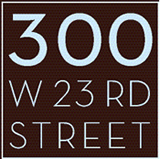Our Historical Neighborhood – An Anecdotal History of New York City with Glimpses into the Past of Particular Relevance to 300 West 23rd Street
Our neighbor Joe Polacek offers us this look at our surroundings – part memoir and part historical discourse – to enhance our appreciation for our building and neighborhood.
Chapter 2
In the 1700’s, before George Washington was sworn in as president, he engaged in a battle with the British General Howe in Brooklyn (Brooklyn Heights section) and was badly defeated. Fortunately, he was able to retreat with his troops across the East River to lower Manhattan, which of course was New York City.
General Howe decided to finish off Washington once and for all. He followed Washington across the river and headed north on the East Road (Boston Post Road, corresponding approximately to 3rd Avenue or Lexington Avenue.) Circumventing Turtle Bay and Kips Bay, he planned to go as far north as the Transverse Road (now 42nd Street) and cut off Washington from escape by land. Since Washington was blockaded by water, he would have to surrender.
Washington, sensing he must escape as soon as possible, organized his troops and headed at a quick pace along Broadway, which was on the east side but veered towards the west. Under various names, Broadway ran outside of New York City, and it was called longest road in America, ending in Albany.
Fortunately for the United States, and unfortunately for the British, a Mrs. Murray, whose house stood on a hill at approximately 37th Street and Park Avenue South, pretended to be a Tory, friendly to the British cause. She invited General Howe and all his troops to refreshments. She plied them with food and drink and delayed them long enough to allow Washington to pass the Transverse Road and escape north. In appreciation for the deed, we now call that part of the City Murray Hill, for Mrs. Murray.
By the time General Howe continued his chase, he was too late and Washington had escaped. Only a small skirmish – shooting from behind stone walls – took place at the site where the reservoir was later built, now the site of the New York Public Library at 5th Avenue and 42nd Street. Washington marched north at a fast pace and finally stopped to make camp high on the bluffs at 128th Street, known to this day known as Washington Heights.
I mentioned in Chapter One that London Terrace and our building were built during the same time period. Our building had the advantage of being a whole block from the 9th Avenue “El,” as the elevated trains were called. The station at 23rd Street and 9th Avenue made life a little unpleasant for residents of London Terrace, as the trains would screech to a halt and start up again, always noisier than just having trains pass by. Before the “Els” were electrified, many belched black smoke into open windows, which made living along the side of the “Els” even more unpleasant. To the east of our building were the 6th Avenue “El” and farther away the 3rd Avenue “El.”
For those living on the east side of our building, the 8th Avenue side, we can see a tall, slender black building raising at 25th Street and Madison Avenue. A beautiful old mansion which stood across the street from the original Madison Square Garden was demolished in order to build that black building. That mansion was the home in which Winston Churchill’s mother was born.
Also, the rooftops seen out of the windows on the east side of the building were the actual locations of the earliest movie studios. Small room size studios were created, built on revolving dishes and put on the roofs to capture the sunlight needed for filming.
During the time from 1930 to 1950, many tenants of our building had housekeepers. I can remember making a delivery in 1949 (long before I was a resident), going through the basement and seeing about six maids washing clothes. The wall between the Resident Manager’s office and the present laundry room did not exist. Instead, there was one big laundry room with many large tubs and many permanent ironing boards on the opposite wall.
In the laundry room, four inch thick pipes ran the length of the room along the wall then curved back to join another pipe lower down the wall and then snaked back and forth to perhaps four feet off the ground. The maids used these pipes, which were continually warmed by hot water, to hang layers of bed sheets, tablecloths, etc. This removed most wrinkles and dried the sheets at the same time.
![]() All documents are in Adobe Acrobat (PDF) format.
All documents are in Adobe Acrobat (PDF) format.
Need Free Acrobat reader software?
Click here.
© Copyright 300 W 23rd Building 2025
